Evaluation of Urban Sustainability Based on Development Structures and Economic Aggregates: A Case Study of Jiaxing, China
Abstract
:1. Introduction
2. Materials and Methods
2.1. Study Area and Data Sources
2.2. Research Method
2.2.1. Emergy Accounting
2.2.2. Quantification of Eco-Environmental Costs in Urban Development Process
- (a)
- Accounting of ecological service values
- (b) Accounting of natural capital and human resources losses
2.2.3. Sustainability Evaluation System of Urban Ecosystem
3. Results and Discussion
3.1. Temporal Variation of Emergy
3.2. Eco-Environmental Costs
3.2.1. Eco-Environmental Costs of Ecological Services
3.2.2. Eco-Environmental Costs of Natural Capital and Human Resources Losses
3.3. Sustainability Evaluation of Urban Development Structures
3.4. Sustainability Evaluation of Urban Economic Aggregates
3.5. Sustainability Evaluation Combining Development Structures and Economic Aggregates
4. Conclusions and Policy Implications
Supplementary Materials
Author Contributions
Funding
Institutional Review Board Statement
Informed Consent Statement
Data Availability Statement
Acknowledgments
Conflicts of Interest
References
- Wang, Y.; Yuan, G.; Yan, Y.; Zhang, X. Evaluation of sustainable urban development under environmental constraints: A case study of Jiangsu province, China. Sustainability 2020, 12, 1049. [Google Scholar] [CrossRef]
- Wei, Y.; Huang, C.; Lam, P.T.I.; Sha, Y.; Feng, Y. Using urban-carrying capacity as a benchmark for sustainable urban development: An empirical study of Beijing. Sustainability 2015, 7, 3244–3268. [Google Scholar] [CrossRef]
- Cai, C.; Shang, J. Comprehensive evaluation on urban sustainable development of Harbin city in northeast China. Chin. Geogr. Sci. 2009, 19, 144–150. [Google Scholar] [CrossRef]
- Yan, Y.; Wang, C.; Quan, Y.; Wu, G.; Zhao, J. Urban sustainable development efficiency towards the balance between nature and human well-being: Connotation, measurement, and assessment. J. Clean. Prod. 2018, 178, 67–75. [Google Scholar] [CrossRef]
- Sun, X.; Liu, X.; Li, F.; Tao, Y.; Song, Y. Comprehensive evaluation of different scale cities’ sustainable development for economy, society, and ecological infrastructure in China. J. Clean. Prod. 2017, 163, 329–337. [Google Scholar] [CrossRef]
- Yang, B.; Xu, T.; Shi, L. Analysis on sustainable urban development levels and trends in China’s cities. J. Clean. Prod. 2017, 141, 868–880. [Google Scholar] [CrossRef]
- Hopwood, B.; Mellor, M.; O’Brien, G. Sustainable development: Mapping different approaches. Sustain. Dev. 2005, 13, 38–52. [Google Scholar] [CrossRef]
- Zang, L.; Su, Y. Internal coordinated development of China’s urbanization and its spatiotemporal evolution. Sustainability 2019, 11, 626. [Google Scholar] [CrossRef]
- Wen, Z.G.; Zhang, K.M.; Huang, L.; Du, B.; Chen, W.Q.; Li, W. Genuine saving rate: An integrated indicator to measure urban sustainable development towards an ecocity. Int. J. Sustain. Dev. World 2005, 12, 184–196. [Google Scholar] [CrossRef]
- Wen, Z.; Zhang, K.; Du, B.; Li, Y.; Li, W. Case study on the use of genuine progress indicator to measure urban economic welfare in China. Ecol. Econ. 2007, 63, 463–475. [Google Scholar] [CrossRef]
- Lawn, P.A. A theoretical foundation to support the Index of Sustainable Economic Welfare (ISEW), Genuine Progress Indicator (GPI), and other related indexes. Ecol. Econ. 2003, 44, 105–118. [Google Scholar] [CrossRef]
- Zhang, M.; Xiao, H.; Sun, D.; Li, Y. Spatial differences in and influences upon the sustainable development level of the Yangtze River Delta urban agglomeration in China. Sustainability 2018, 10, 411. [Google Scholar] [CrossRef]
- Lu, L.; Hu, S.; He, J.; Zeng, G. Relationship between green development and economic growth of Yangtze River Delta urban agglomeration: Based on the decoupling index analysis. Econ. Geogr. 2020, 40, 40–48. [Google Scholar]
- Hammer, J.; Pivo, G. The Triple Bottom Line and Sustainable Economic Development Theory and Practice. Econ. Dev. Q. 2017, 31, 25–36. [Google Scholar] [CrossRef]
- Pan, Y.; Zhang, B.; Wu, Y.; Tian, Y. Sustainability assessment of urban ecological-economic systems based on emergy analysis: A case study in Simao, China. Ecol. Indic. 2021, 121, 107157. [Google Scholar] [CrossRef]
- Fang, G.; Tian, L.; Yang, Z. The construction of a comprehensive multidimensional energy index. Energy Econ. 2020, 90, 104875. [Google Scholar] [CrossRef]
- Jing, Z.; Wang, J. Sustainable development evaluation of the society-economy-environment in a resource-based city of China: A complex network approach. J. Clean. Prod. 2020, 263, 121510. [Google Scholar] [CrossRef]
- Wang, Q.; Yuan, X.; Zhang, J.; Gao, Y.; Hong, J.; Zuo, J.; Liu, W. Assessment of the Sustainable Development Capacity with the Entropy Weight Coefficient Method. Sustainability 2015, 7, 13542–13563. [Google Scholar] [CrossRef]
- Calicioglu, O.; Bogdanski, A. Linking the bioeconomy to the 2030 sustainable development agenda: Can SDG indicators be used to monitor progress towards a sustainable bioeconomy? New Biotechnol. 2021, 61, 40–49. [Google Scholar] [CrossRef]
- Chen, Y.; Peng, L.; Cao, W. Health evaluation and coordinated development characteristics of urban agglomeration: Case study of Fujian Delta in China. Ecol. Indic. 2021, 121, 107149. [Google Scholar] [CrossRef]
- Lu, H.-F.; Tan, Y.-W.; Zhang, W.-S.; Qiao, Y.-C.; Campbell, D.E.; Zhou, L.; Ren, H. Integrated emergy and economic evaluation of lotus-root production systems on reclaimed wetlands surrounding the Pearl River Estuary, China. J. Clean. Prod. 2017, 158, 367–379. [Google Scholar] [CrossRef] [PubMed]
- Odum, H.T. Self-organization, transformity, and information. Science 1988, 242, 1132–1139. [Google Scholar] [CrossRef]
- Liu, G.; Yang, Z.; Chen, B.; Ulgiati, S. Monitoring trends of urban development and environmental impact of Beijing, 1999–2006. Sci. Total Environ. 2011, 409, 3295–3308. [Google Scholar] [CrossRef]
- Ascione, M.; Campanella, L.; Cherubini, F.; Ulgiati, S. Environmental driving forces of urban growth and development An emergy-based assessment of the city of Rome, Italy. Landsc. Urban Plan. 2009, 93, 238–249. [Google Scholar] [CrossRef]
- Fan, Y.; Fang, C. Evolution process analysis of urban metabolic patterns and sustainability assessment in western China, a case study of Xining city. Ecol. Indic. 2020, 109, 105784. [Google Scholar] [CrossRef]
- Chen, W.; Zhong, S.; Geng, Y.; Chen, Y.; Cui, X.; Wu, Q.; Pan, H.; Wu, R.; Sun, L.; Tian, X. Emergy based sustainability evaluation for Yunnan Province, China. J. Clean. Prod. 2017, 162, 1388–1397. [Google Scholar] [CrossRef]
- Fang, G.; Wang, Q.; Tian, L. Green development of Yangtze River Delta in China under Population-Resources-Environment-Development-Satisfaction perspective. Sci. Total Environ. 2020, 727, 138710. [Google Scholar] [CrossRef]
- Wei, Y.; Li, Y.; Liu, X.; Wu, M. Sustainable development and green gross domestic product assessments in megacities based on the emergy analysis method-A case study of Wuhan. Sustain. Dev. 2020, 28, 294–307. [Google Scholar] [CrossRef]
- Markantonis, V.; Meyer, V.; Lienhoop, N. Evaluation of the environmental impacts of extreme floods in the Evros River basin using Contingent Valuation Method. Nat. Hazards 2013, 69, 1535–1549. [Google Scholar] [CrossRef]
- Liu, J.; Zhu, Y.; Zhang, Q.; Cheng, F.; Hu, X.; Cui, X.; Zhang, L.; Sun, Z. Transportation carbon emissions from a perspective of sustainable development in major cities of Yangtze River Delta, China. Sustainability 2021, 13, 192. [Google Scholar] [CrossRef]
- Liu, G.Y.; Yang, Z.F.; Chen, B.; Ulgiati, S. Emergy-based urban health evaluation and development pattern analysis. Ecol. Model. 2009, 220, 2291–2301. [Google Scholar] [CrossRef]
- JBS. People’s Republic of China. Jiaxing Statistical Yearbook 2018; China Statistics Press: Beijing, China, 2019. [Google Scholar]
- WRBJ. Jiaxing Water Resources Bulletin; Jiaxing Water Resources Bureau: Jiaxing, China, 2018.
- Zhou, F.; Cheng, J.; Chen, N. Environmental Performance Evaluation Report of the Yangtze River Economic Zone; Shanghai Academy of Social Sciences Press: Shanghai, China, 2016. [Google Scholar]
- Tang, M.; Hong, J.; Wang, X.; He, R. Sustainability accounting of neighborhood metabolism and its applications for urban renewal based on emergy analysis and SBM-DEA. J. Environ. Manag. 2020, 275, 111177. [Google Scholar] [CrossRef] [PubMed]
- Ulgiati, S.; Brown, M.T.; Bastianoni, S.; Marchettini, N. Emergy-based indices and ratios to evaluate the sustainable use of resources. Ecol. Eng. 1995, 5, 519–531. [Google Scholar] [CrossRef]
- Ulgiati, S.; Brown, M.T. Quantifying the environmental support for dilution and abatement of process emissions—The case of electricity production. J. Clean. Prod. 2002, 10, 335–348. [Google Scholar] [CrossRef]
- Goedkoop, M.; Spriensma, R. The Eco-Indicator 99: A Damage Oriented Method for Life Cycle Impact Assessment; PRé Consultants B.V.: Amersfoort, The Netherlands, 2000. [Google Scholar]
- Zhao, X.; Huang, S.; Wang, J.; Kaiser, S.; Han, X. The impacts of air pollution on human and natural capital in China: A look from a provincial perspective. Ecol. Indic. 2020, 118, 106759. [Google Scholar] [CrossRef]
- Pan, J.; Zhang, H.; Wang, X.; Liu, G. Update methods of the global, national environmental accounting database (NEAD). J. Environ. Plan. Manag. 2017, 5, 105–116. [Google Scholar] [CrossRef]
- Liu, G.; Yang, Z. Emergy Theory and Practice: Ecological, Environmental Accounting and Urban Green Management; Science Press: Beijing, China, 2018. [Google Scholar]
- Qin, F.; Wang, L.; Shao, S. Emergy comparison of typical coastal urban ecosystems in China. Complexity 2020, 2020, 8071242. [Google Scholar] [CrossRef]
- Cano Londono, N.A.; Velasquez, H.I.; McIntyre, N. Comparing the environmental sustainability of two gold production methods using integrated Emergy and Life Cycle Assessment. Ecol. Indic. 2019, 107, 105600. [Google Scholar] [CrossRef]
- Odum, H.J.U. Environmental Accounting: Emergy and Environmental Decision Making; John Wiley & Sons: New York, NY, USA, 1996. [Google Scholar]
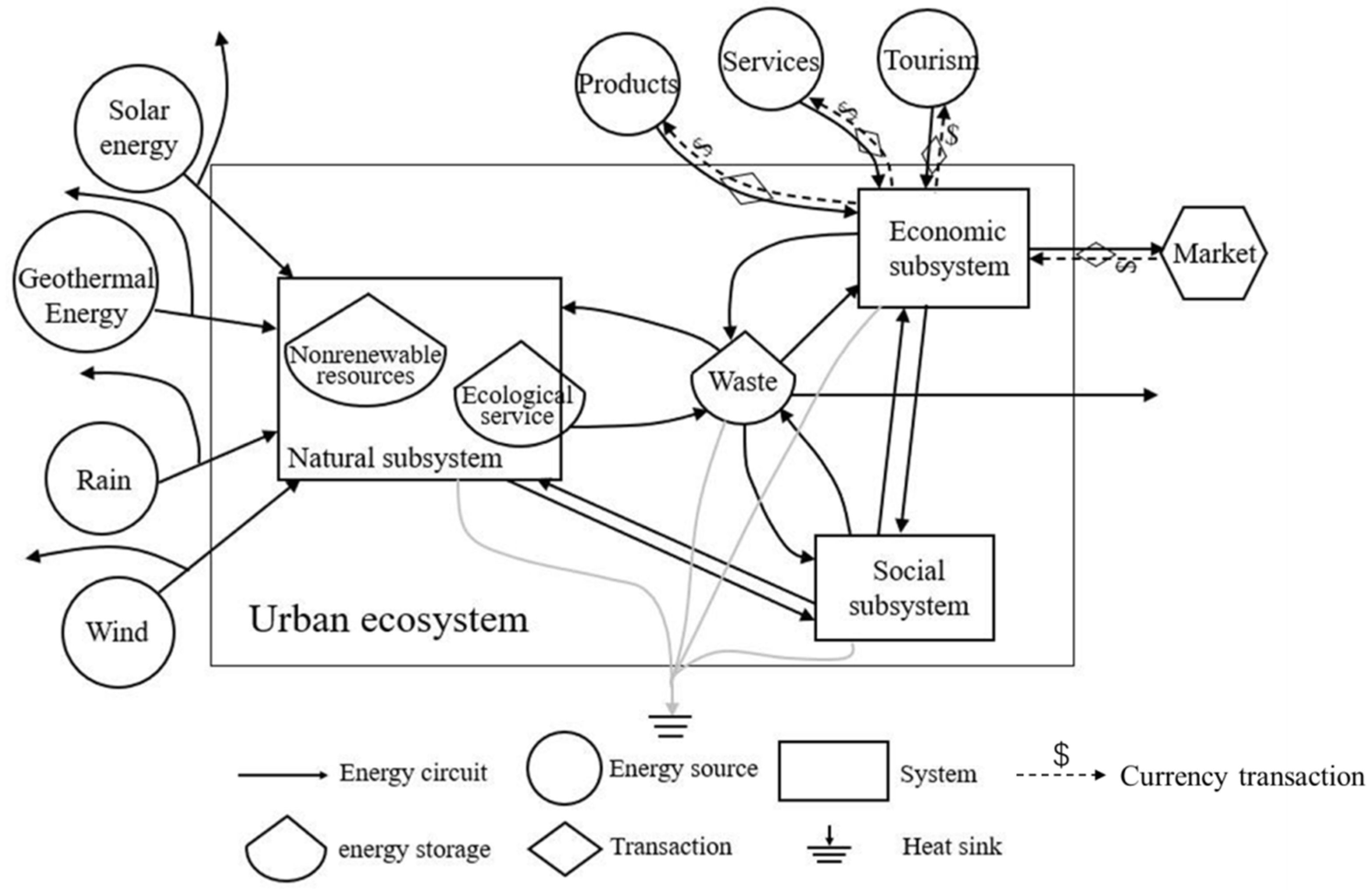
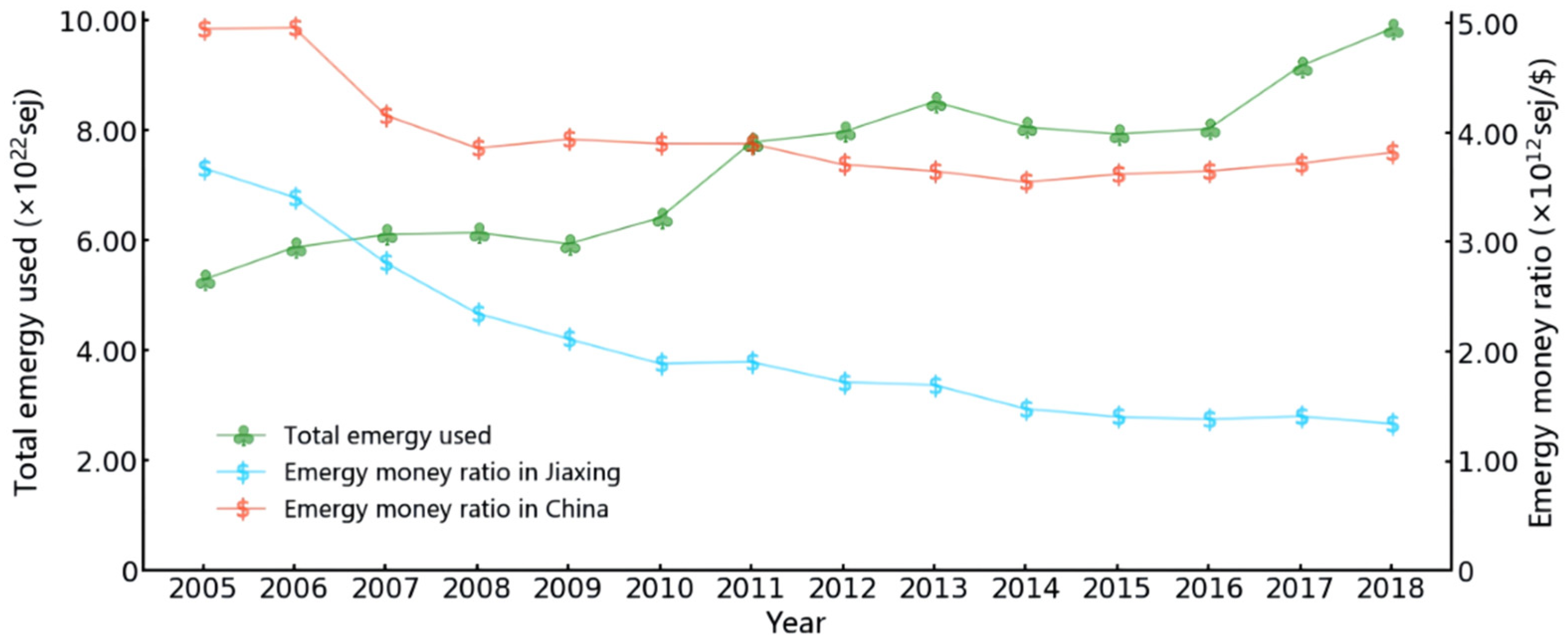
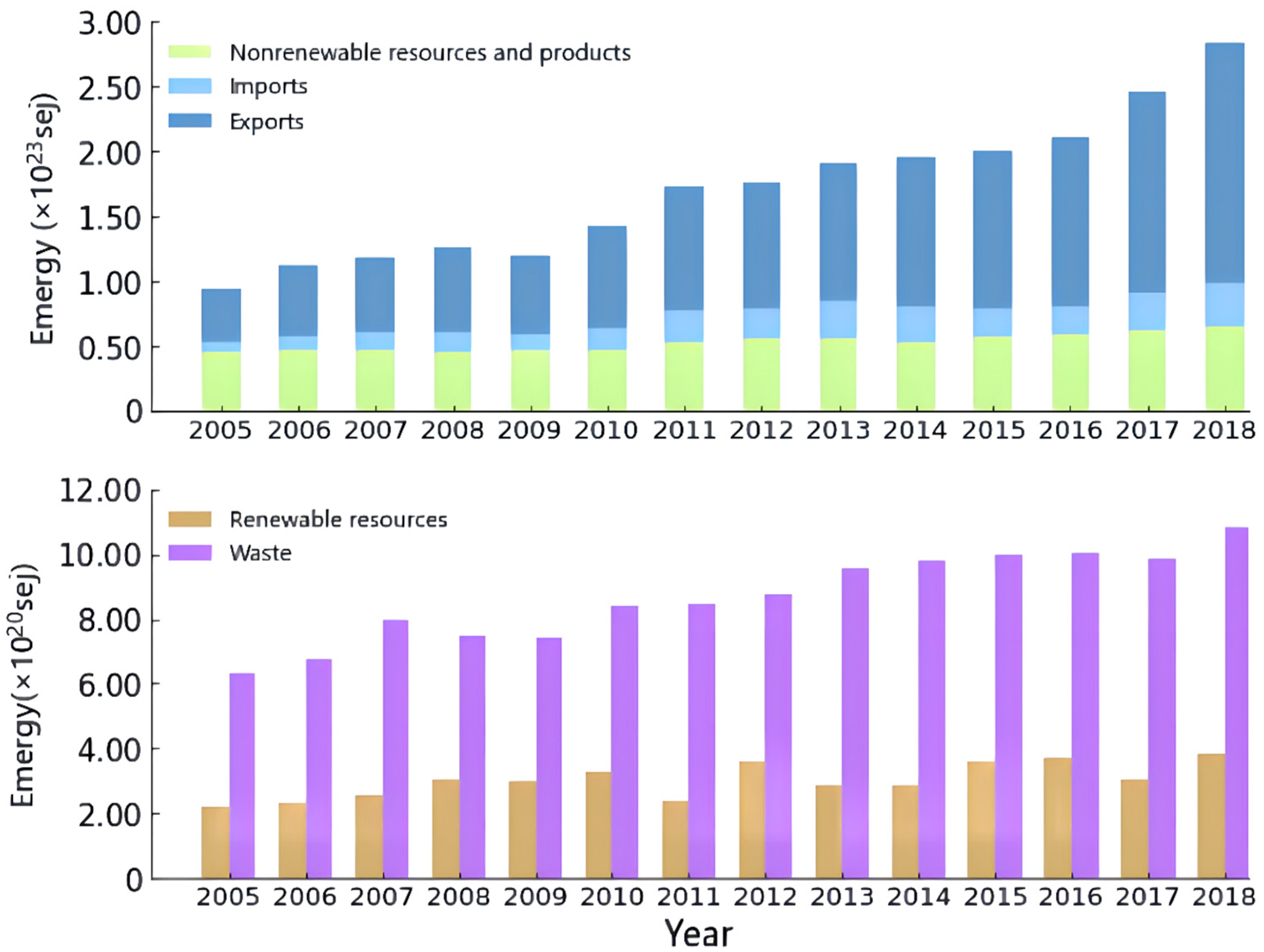
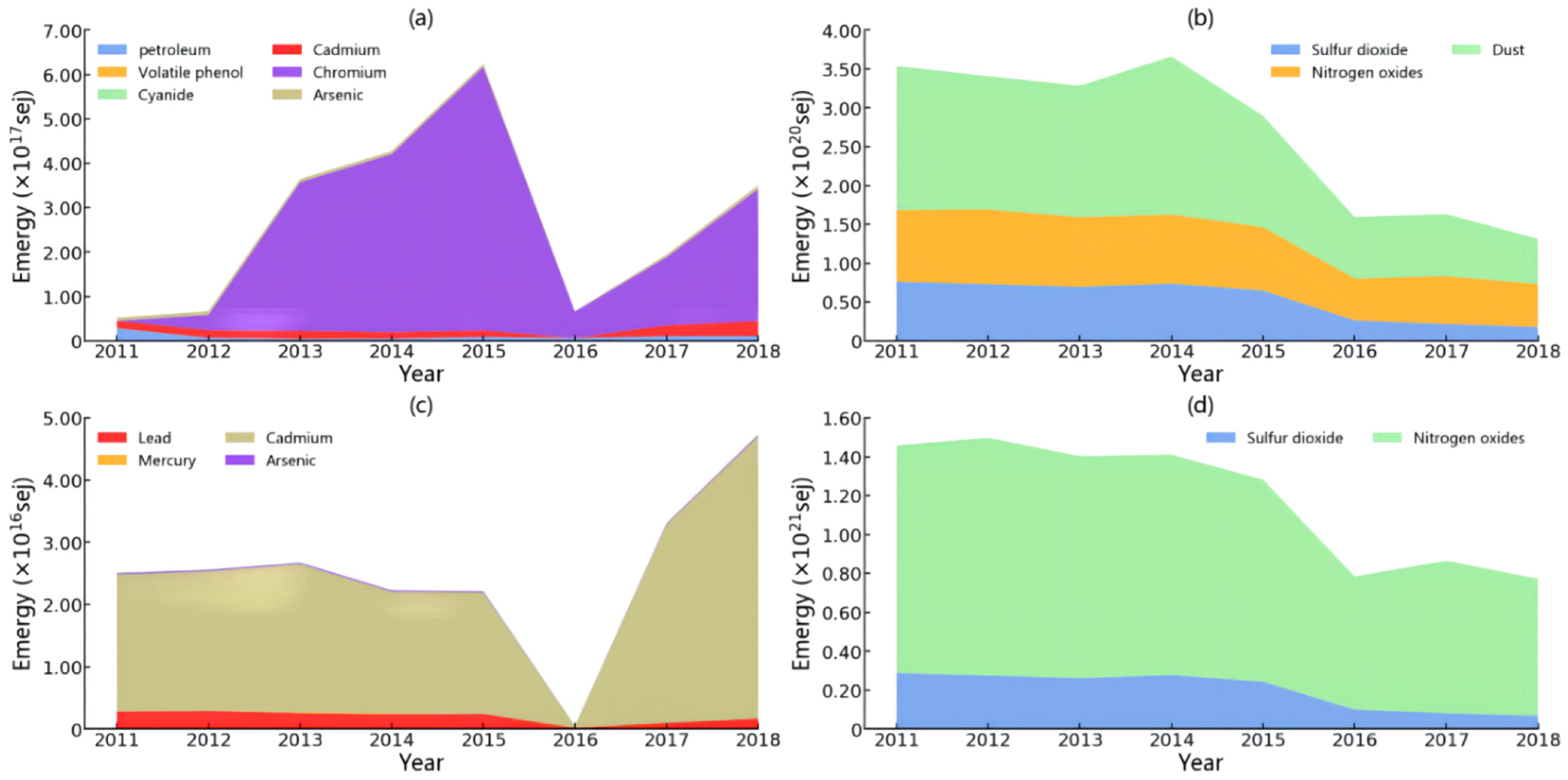
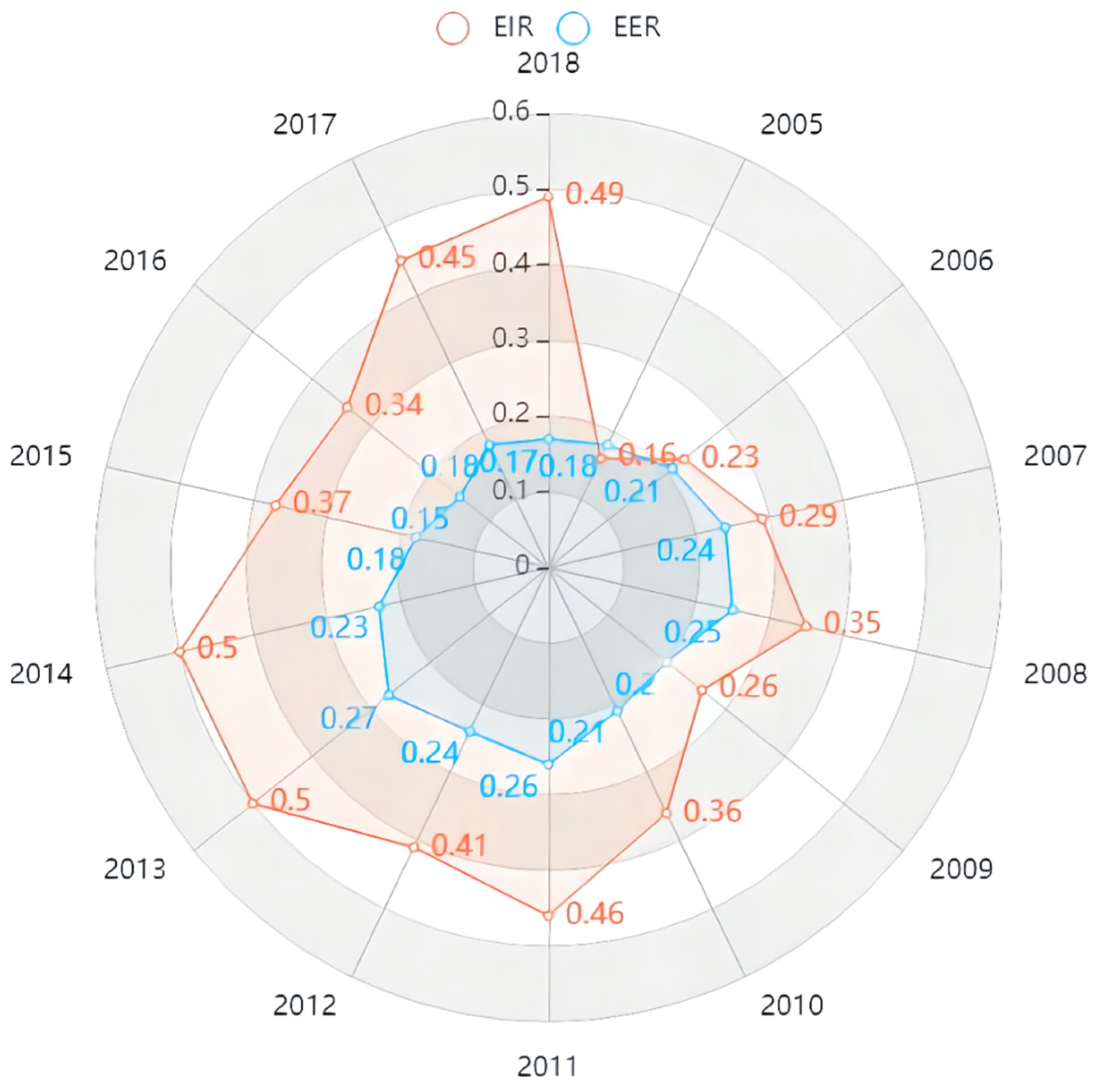
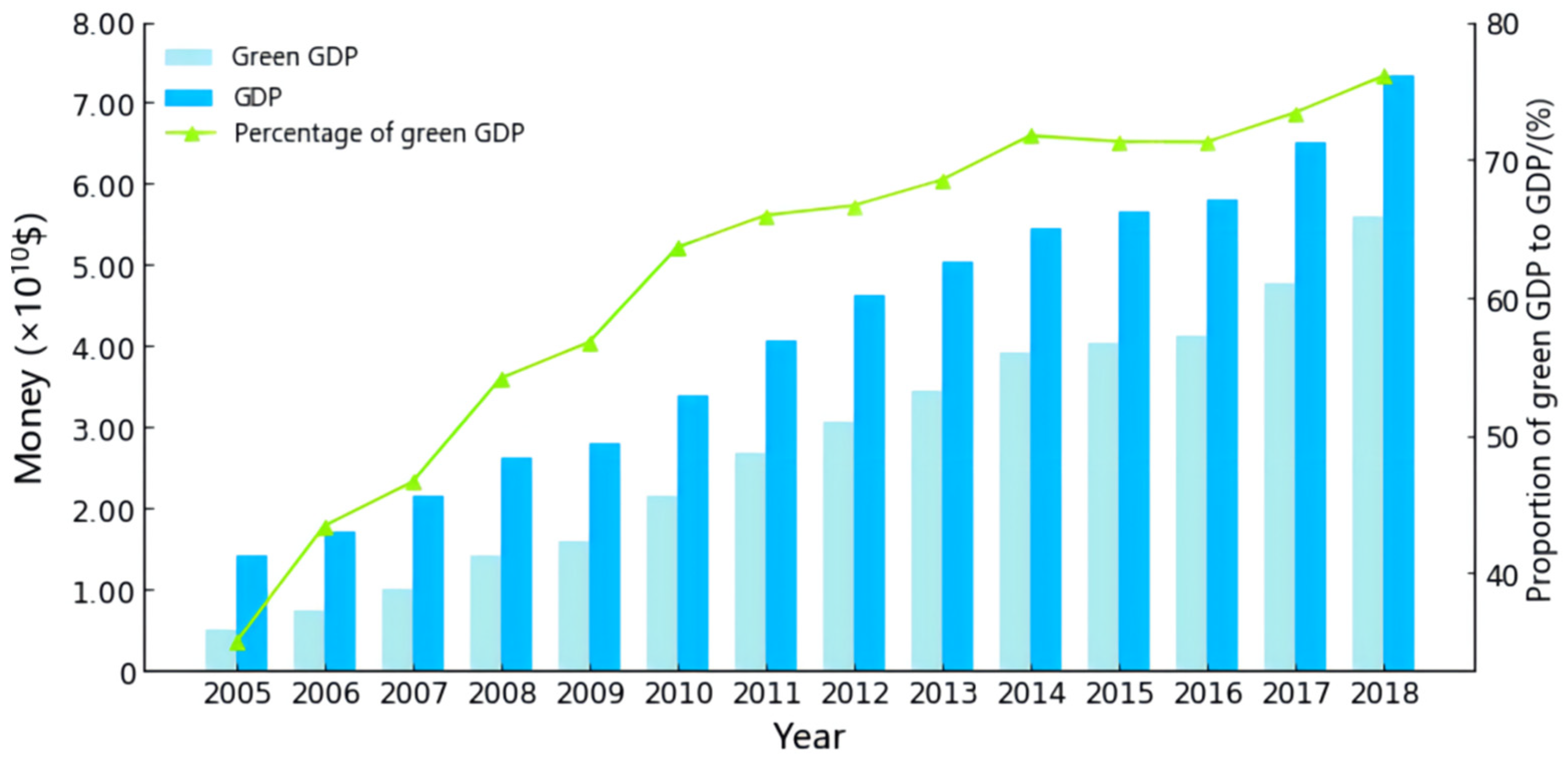
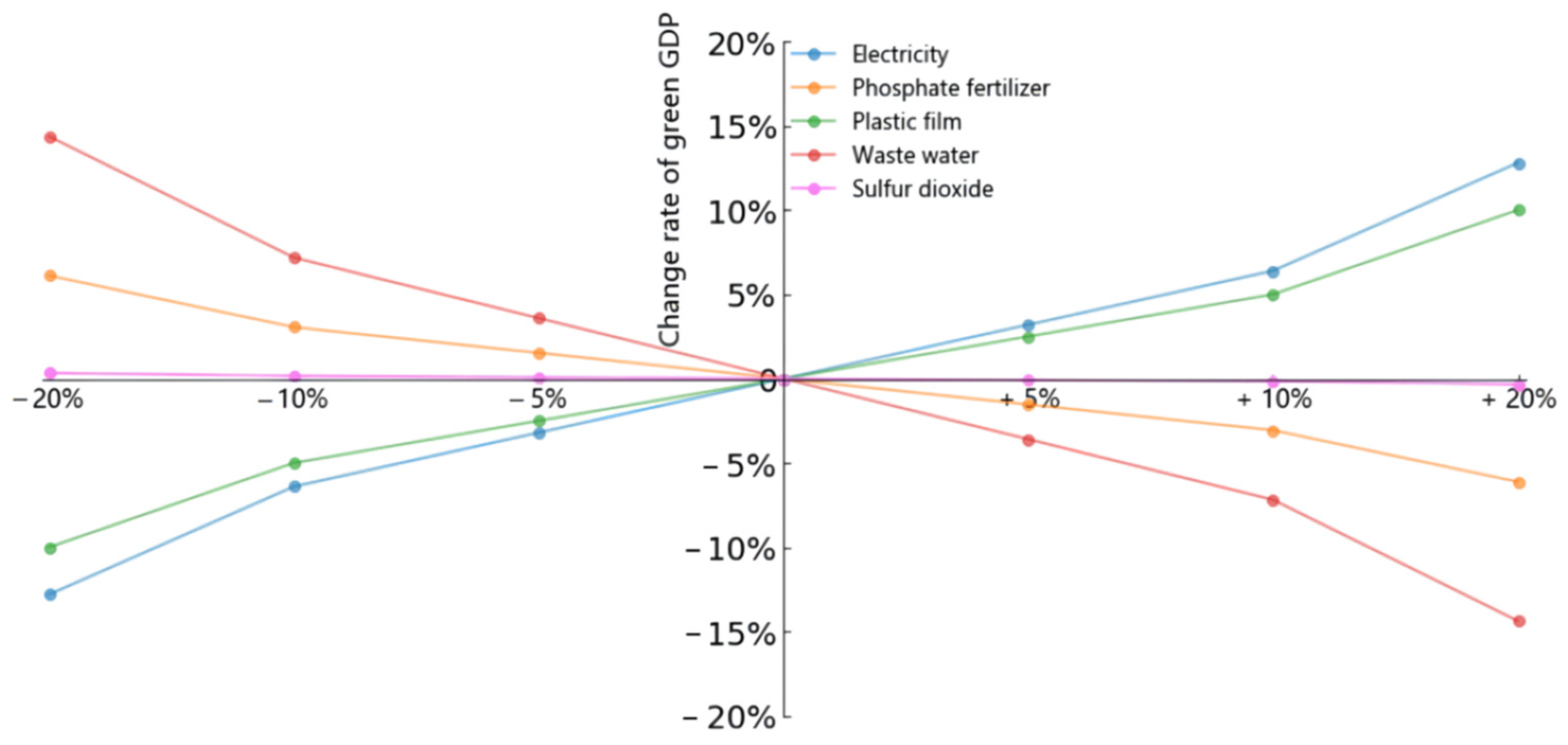
| Item | System | Emergy Evaluation Indicators | Formula a | Meaning |
|---|---|---|---|---|
| Sustainability assessment of development structures | Natural subsystem | Environmental loading ratio (ELR) | (I + N)/R | The pressure of urban social and economic activities on the eco-environment. |
| Waste loading ratio (WLR) | W/R | The pressure of waste from social and economic activities on the eco-environment. | ||
| Social subsystem | Emergy density (ED) | U/A | The intensity of economic activity per unit area in the city. | |
| Emergy per person (EPP) | U/P | The living standards of the residents in the city. | ||
| Economic subsystem | Emergy yield ratio (EYR) | U/I | Economic development efficiency of the urban ecosystem. | |
| Emergy investment ratio (EIR) | I/(R + N) | The degree of coordinated development of economic growth and environmental pressure in the city. | ||
| Emergy exchange ratio (EER) | I/E | The gains and losses of the real value wealth of urban ecosystems in economic trade. | ||
| Urban complex ecosystem | Emergy sustainability index (ESI) | EYR/ELR | Coordination and sustainability of urban development. | |
| Environmental load rate based on eco-environmental costs (ELREC) | (I + N + Rd-water + Rd-air + EPH + EEQ)/R | The pressure of urban ecological environment based on the eco-environmental costs. | ||
| Emergy yield ratio based on eco-environmental costs (EYREC) | (U + Rd-water + Rd-air + EPH + EEQ)/(I + Rd-water + Rd-air + EPH + EEQ) | Development efficiency of urban ecological economy based on the eco-environmental costs. | ||
| Emergy sustainability index based on eco-environmental costs (ESIEC) | EYREC/ELREC | The sustainability of urban ecosystem based on the eco-environmental costs. | ||
| Sustainability assessment of economic aggregates | Green GDP | GDP − EMN − EMW | A measure of the urban economic outputs after deducting the resource and environmental costs in economic activities. | |
Publisher’s Note: MDPI stays neutral with regard to jurisdictional claims in published maps and institutional affiliations. |
© 2022 by the authors. Licensee MDPI, Basel, Switzerland. This article is an open access article distributed under the terms and conditions of the Creative Commons Attribution (CC BY) license (https://creativecommons.org/licenses/by/4.0/).
Share and Cite
Zhang, X.; Liu, Y.; Tleubergenova, A.; Liu, J.-S.; Fan, R.; Tang, Y.-E.; Meng, X.-Z. Evaluation of Urban Sustainability Based on Development Structures and Economic Aggregates: A Case Study of Jiaxing, China. Sustainability 2022, 14, 10683. https://doi.org/10.3390/su141710683
Zhang X, Liu Y, Tleubergenova A, Liu J-S, Fan R, Tang Y-E, Meng X-Z. Evaluation of Urban Sustainability Based on Development Structures and Economic Aggregates: A Case Study of Jiaxing, China. Sustainability. 2022; 14(17):10683. https://doi.org/10.3390/su141710683
Chicago/Turabian StyleZhang, Xufeng, Yanliang Liu, Akmaral Tleubergenova, Jin-Song Liu, Ru Fan, Yun-En Tang, and Xiang-Zhou Meng. 2022. "Evaluation of Urban Sustainability Based on Development Structures and Economic Aggregates: A Case Study of Jiaxing, China" Sustainability 14, no. 17: 10683. https://doi.org/10.3390/su141710683
APA StyleZhang, X., Liu, Y., Tleubergenova, A., Liu, J.-S., Fan, R., Tang, Y.-E., & Meng, X.-Z. (2022). Evaluation of Urban Sustainability Based on Development Structures and Economic Aggregates: A Case Study of Jiaxing, China. Sustainability, 14(17), 10683. https://doi.org/10.3390/su141710683








